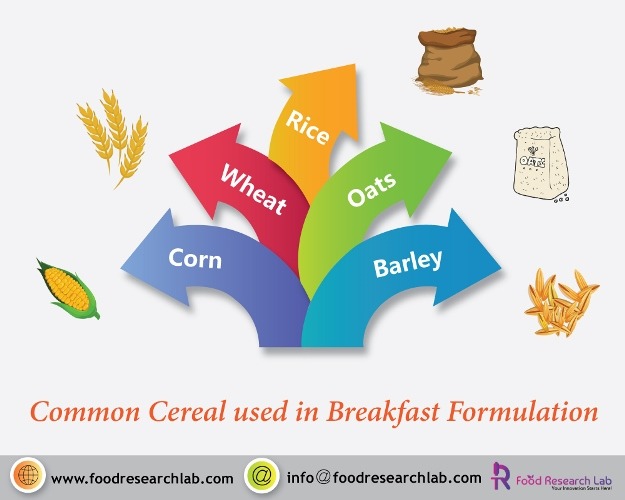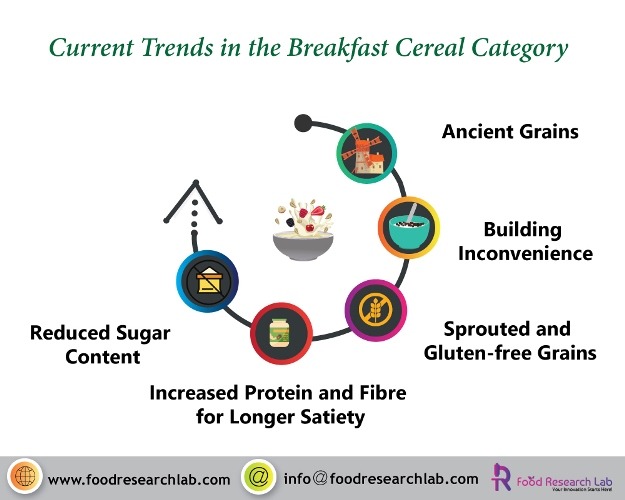Consumers prefer new cereal trends in the health food category compared to a usual household staple. Food development companies want to grow sales and must meet new consumer expectations despite indications that the cereal market is reducing. The breakfast cereal category is expected to offer more on-the-go and health-conscious options, which could be a challenge for scientists and manufacturers. Cereal can be consumed as whole grains which are rich in vitamins, minerals, fats, oils, carbohydrates and proteins. However, if they are processed to remove bran and germ, the cereal remains with endocarp which is majorly carbohydrates and lacks the nutrients. Cereal processing commonly utilizes extrusion to create novel breakfast foods.
Breakfast Cereal Formulation and Trends
Introduction
Consumers prefer new cereal trends in the health food category compared to a usual household staple. Food development companies want to grow sales and must meet new consumer expectations despite indications that the cereal market is reducing. The breakfast cereal category is expected to offer more on-the-go and health-conscious options, which could be a challenge for scientists and manufacturers. Cereal can be consumed as whole grains which are rich in vitamins, minerals, fats, oils, carbohydrates and proteins. However, if they are processed to remove bran and germ, the cereal remains with endocarp which is majorly carbohydrates and lacks the nutrients. Cereal processing commonly utilizes extrusion to create novel breakfast foods.
Extrusion
We have covered quite extensively on types of extruders, how to choose them and also the innovations happening in the food industry. Cereals need to be cooked to gelatinize the starch under controlled time, temperature and humidity to make it digestible and commercially acceptable. Any type of cereal could be processed using an extruder. However, the main issue is that the functional cereals are limited to corn and rice. Cereals with high lipid profile will not expand in the extruder barrel. Therefore cereals with starch content with 5 to 20 % amylose content will improve the expansion of cereals. (1)

Common cereal used in breakfast formulation
Corn
Corn or maize is one of the main ingredients for breakfast cereals and extruded snacks. Large amounts of corn are used in puffed up meals. Cornmeal, flour, grits (and their degree of granulation) depend on the type of snack products, particle size distribution and type of extruder. For instance, a crunchy texture requires a larger cell structure and coarse granulation. However, for oats porridge a softer bite is required for which a fine texture and cell structure is required. (2)
Wheat
Wheat flour is used for snack products such as baked/fried snacks, crackers, pretzels etc. Semolina product has a similar expansion ratio and bulk density to that of cornmeal; therefore, snacks with semolina will have a crispy texture. In any snacks, gluten in wheat provides nutritional value and crispiness. Milling the byproducts of wheat can be used with other ingredients such as soy protein to produce expanded snacks or cereals with high nutritional value. However, having high nutritional benefits, the use of wheat is limited due to its high cost.
Rice
Rice is one of the common and largest grown and consumed crop in the world, especially in countries like Japan and India. Due to the high production of rice, their cost is relatively cheaper than other cereals or snack ingredients. Broken rice is also used as an ingredient in expanded snacks, breakfast cereals due to its functional properties. Moreover, rice is also easily digestible due to its small starch granules. The selection of the rice for extruded food formulation should depend on their amylose content. Crisps made with 100 % rice flour will absorb 20 – 30 % less oil during frying.
Oats
For breakfast cereals, oats are marketed as rolled oats. Oats have shown to reduce cholesterol in blood serum. However, their major problem is their high oil content and contains lipase enzymes. Therefore it is essential to inactive the lipase before utilizing it in the food formulation, otherwise, lipase will catalyze the hydrolysis of oil causing bitter-tasting fatty acids. Oat starch granules also are comparatively small when compared to other starches. Oat requires a relatively low temperature for gelatinisation; the however higher amount of energy is required for cooking due to its higher oil and fibre content. Oats have a poor expansion ratio; therefore they are used in porridge, granola or muesli.
Barley
Barley is nutritionally similar to wheat in most aspects except contains exceptionally high fibre content. Barley’s starch granules are medium to large in size when compared to other cereals. Therefore, barley is often used in small quantities for cereals and snacks. Barley starch needs low to medium cooking temperature for gelatinizing and produces a mild flavour, and light brown to gold colour to the product. Manufacturers include barley in food formulations to improve fibre supplementation or as a multi-grain snack.
Current Trends in the breakfast cereal category
Reduced sugar content
Almost 40% of breakfast consumers prefer to opt for low sugar options, which add a challenge to the food industries. Some of the common consumers approved ingredients are coconut sugar, dried fruits and honey, which showcases the perfect balance between sweet and healthy option.

Increased protein and fibre for longer satiety
Protein and fibre content go hand in hand for better health and wellness conscious consumers. Food scientist and nutritionist say there is a simple equation for a satisfying breakfast or meal. For a balanced breakfast, consumers can add ingredients rich in fibre (whole grains, fruits and nuts), proteins (eggs, whites, tofu, cheese and yoghurt) and good fat (nuts), upon which they will feel fuller for a long time. Recently manufacturers are also using proteins for new product development from nuts and soy-based products.
Sprouted and gluten-free grains
Germinating seeds can be eaten raw or cooked which aids in nutritional benefits and digestibility. Brands such as Food for Life launched the all-new Sprouted for Life grain cereals in January, which is rich in protein and fibre. Kellogg’s has introduced Sprouted Grains Multi-grain organic cereal with whole flakes along with brown rice, oats, barley and amaranth. New gluten-free cereal options are highly recommended for people with celiac disease and gluten-sensitive consumers. Sprouted cinnamon cereal made with gluten-free buckwheat, sunflower seeds, barley and pumpkin seeds. (3)
Building inconvenience
Brands are competing to gain more shelf space for their portable breakfast cereals, granola bars and yoghurts. Some of the exclusive options also include ready to go cereals that do not even require milk for added convenience.
Ancient Grains
Cheerios + highlighted another trend that seems to be rocking social media. Cereal manufacturers have noticed the health halo consumers are associating with whole grains. Some consumers are using quinoa to incorporate ancient grains into their morning routine, which is quick, nutritious and delicious.
For a one-stop solution gets in touch with Food Research Lab. We are well equipped and ready with all the information for food formulation services you would need.

Let’s create something Innovative and Delicious together
Food Research Lab strives for excellence in new Food, Beverage and Nutraceutical Product Research and Development by offering cutting edge scientific analysis and expertise.




